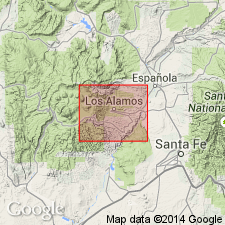
- Usage in publication:
-
- Otowi Member*
- Modifications:
-
- Original reference
- Dominant lithology:
-
- Tuff
- Pumice
- AAPG geologic province:
-
- San Juan basin
Summary:
Pg. 18 (fig. 8), 48-49, pl. 1. Otowi Member of Bandelier Tuff of Tewa Group. A buff-colored massive aggregate of poorly sorted rhyolitic pumice fragments and some fine pumiceous glass, all of which weathers to a chalky light gray. Throughout Los Alamos area, north-central New Mexico, it is chiefly a single pumice flow. Thickness 0 to 215 feet. The 215-foot-thick section is in test hole 19.6.17.234. Overlies Guaje Member (new); underlies Tshirege Member (new). Where Guaje Member is absent the Otowi rests on pre-Bandelier erosion surface which was cut on Puye Conglomerate, the old alluvium unit and the basaltic rocks of Chino Mesa. Age is Pleistocene.
Type locality: Otowi section of Bandelier National Monument. Named for exposures in vicinity of Otowi ruins, NE/4 NE/4 sec. 18, T. 19 N., R. 7 E., in Pueblo Canyon, Bandelier National Monument, [Espanola 15-min quadrangle], Santa Fe Co., north-central NM.
Source: US geologic names lexicon (USGS Bull. 1350, p. 545-546).
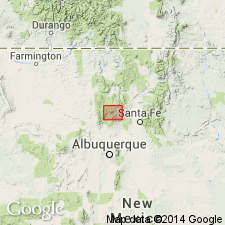
- Usage in publication:
-
- Otowi Member*
- Modifications:
-
- Geochronologic dating
- Paleomagnetics
- AAPG geologic province:
-
- San Juan basin
Summary:
Informal upper and lower members of Bandelier Tuff (following usage of Smith and Bailey, 1966) dated by K-Ar method on anorthoclase and sanidine samples taken in Valles caldera, Jemez Mountains, Sandoval Co, NM in San Juan basin. Lower member--called the Otowi Member, and underlying Guaje Member by Griggs (1964)--dated on sanidine as 1.4 m.y. old. [Note that author uses "lower member", not "Otowi Member", as geologic name--however, Otowi is inferred.] Upper member--called the Tshirege Member by Griggs (1964)--dated on anorthoclase and sanidine as 1.0 m.y. old. Has reversed magnetic polarity. Is of early Pleistocene age.
Source: GNU records (USGS DDS-6; Denver GNULEX).
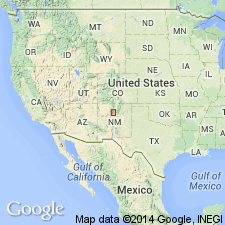
- Usage in publication:
-
- Otowi Member*
- Modifications:
-
- Revised
- AAPG geologic province:
-
- San Juan basin
Summary:
Bandelier Tuff of Tewa Group, previously divided informally into "upper" and "middle" members, with Santa Clara Pumice Bed at base of "middle" member, revised and divided into two formal members: 1) Otowi Member (at base), whose lower contact is extended to include the basal pumice fall, Guaje Member of Griggs (reduced in rank to Guaje Pumice Bed) and the overlying unnamed ash-flow units (Otowi Member of Griggs); and 2) Tshirege Member (at top), which includes a basal pumice fall, named Tsankawi Pumice Bed (new), and the overlying unnamed ash-flow units (Tshirege Member of Griggs). Ash-flow units not formally named in either member. Is in Jemez Mountains, Sandoval Co, NM in San Juan basin.
Source: GNU records (USGS DDS-6; Denver GNULEX).
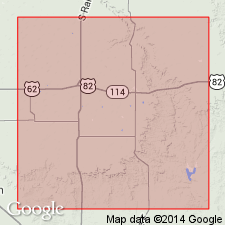
- Usage in publication:
-
- Otowi Member*
- Modifications:
-
- Paleomagnetics
- AAPG geologic province:
-
- San Juan basin
Summary:
A rhyolite volcanic ash bed about 1 ft thick is exposed in a roadcut along TX Hwy 193 in upper part of sequence of Lower Pleistocene sedimentary deposits at type locality of Blanco Formation about 37 mi northeast of Lubbock, TX, in Permian basin. This ash has chemical and petrographic characteristics matching the rhyolite air-fall tephra (Pleistocene Guaje Pumice Bed of the Otowi Member of the Bandelier Tuff) that immediately underlies the unnamed ash flows of Otowi in the Jemez Mountains of northern NM, in San Juan basin. Composition of glass phase of the ash matches that of Guaje for all major elements (except K and Na). Paleomagnetic measurements indicate that the ash has reverse depositional remanent magnetization. Sanidine from Guaje Pumice Bed and its genetically related overlying ash-flow sheet in Jemez Mountains has been K-Ar dated at about 1.4 m.y. by Doell and others (1968). Correlation of the ash bed near Mount Blanco, TX, with the Guaje has implications concerning the duration of the well-known Blancan Land Mammal age.
Source: GNU records (USGS DDS-6; Denver GNULEX).
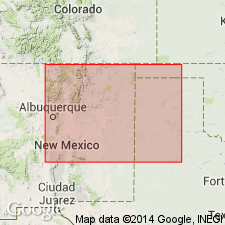
- Usage in publication:
-
- Otowi Member*
- Modifications:
-
- Geochronologic dating
- Age modified
- AAPG geologic province:
-
- Estancia basin
- Palo Duro basin
- Permian basin
- San Juan basin
Summary:
Pg. 38 (fig. 11), 39 (table 10), 40 (table 11). Otowi Member of Bandelier Tuff. Reported K-Ar ages of Doell and others (GSA Mem. 116, 1968) are recalculated using new decay constants of Steiger and Jager (1977). Age of Guaje Pumice Bed is 1.4 +/-0.04 Ma; overlying ash flows, 1.48 +/-0.04 Ma and 1.52 +/-0.09 Ma.
Notable localities (Guaje Pumice Bed) in eastern Jemez Mountains, north-central NM, and southern High Plains, eastern NM and panhandle of TX (Bernalillo, DeBaca, and Santa Fe Cos., NM, and Crosby and Lubbock Cos., TX).
Source: Publication.
For more information, please contact Nancy Stamm, Geologic Names Committee Secretary.
Asterisk (*) indicates published by U.S. Geological Survey authors.
"No current usage" (†) implies that a name has been abandoned or has fallen into disuse. Former usage and, if known, replacement name given in parentheses ( ).
Slash (/) indicates name conflicts with nomenclatural guidelines (CSN, 1933; ACSN, 1961, 1970; NACSN, 1983, 2005, 2021). May be explained within brackets ([ ]).

